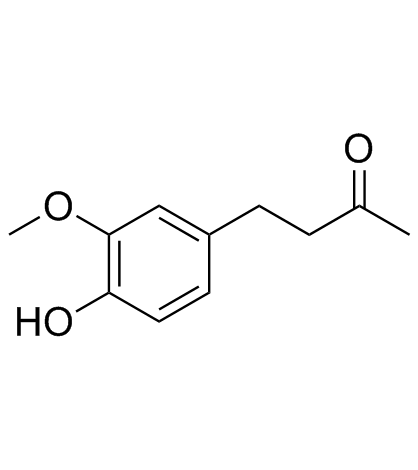Effects of zingerone [4-(4-hydroxy-3-methoxyphenyl)-2-butanone] and eugenol [2-methoxy-4-(2-propenyl)phenol] on the pathological progress in the 6-hydroxydopamine-induced Parkinson's disease mouse model.
Hideaki Kabuto, Tomoko T Yamanushi
文献索引:Neurochem. Res. 36(12) , 2244-9, (2011)
全文:HTML全文
摘要
Parkinson's disease (PD) is characterized by progressive degeneration of dopaminergic neurons in the nigrostriatal system and dopamine (DA) depletion in the striatum. The most popular therapeutic medicine for treating PD, 3-(3,4-Dihydroxyphenyl)-L-alanine (L-DOPA), has adverse effects, such as dyskinesia and disease acceleration. As superoxide (·O(2)(-)) and hydroxyl radical (·OH) have been implicated in the pathogenesis of PD, free radical scavenging and antioxidants have attracted attention as agents to prevent disease progression. Rodents injected with 6-hydroxydopamine (6-OHDA) intracerebroventricularly are considered to be a good animal model of PD. Zingerone and eugenol, essential oils extracted from ginger and cloves, are known to have free radical scavenging and antioxidant effects. Therefore, we examined the effects of zingerone and eugenol on the behavioral problems in mouse model and on the DA concentration and antioxidant activities in the striatum after 6-OHDA administration and L-DOPA treatment. Daily oral administration of eugenol/zingerone and injection of L-DOPA intraperitoneally for 4 weeks following a single 6-OHDA injection did not improve abnormal behaviors induced by L-DOPA treatment. 6-OHDA reduced the DA level in the striatum; surprisingly, zingerone and eugenol enhanced the reduction of striatal DA and its metabolites. Zingerone decreased catalase activity, and increased glutathione peroxidase activity and the oxidized L-ascorbate level in the striatum. We previously reported that pre-treatment with zingerone or eugenol prevents 6-OHDA-induced DA depression by preventing lipid peroxidation. However, the present study shows that post-treatment with these substances enhanced the DA decrease. These substances had adverse effects dependent on the time of administration relative to model PD onset. These results suggest that we should be wary of ingesting these spice elements after the onset of PD symptoms.
相关化合物
| 结构式 | 名称/CAS号 | 分子式 | 全部文献 |
|---|---|---|---|
 |
姜酮; 4-(4-羟基-3-甲氧基苯基)-2-丁酮
CAS:122-48-5 |
C11H14O3 |
|
Inhibition by capsaicin and its related vanilloids of compou...
2013-03-14 [Life Sci. 92(6-7) , 368-78, (2013)] |
|
Fenugreek extract as an inducer of cellular death via autoph...
2012-01-01 [BMC Complement Altern. Med. 12 , 202, (2012)] |
|
Targeting antioxidative signal transduction and stress respo...
2006-07-01 [J. Appl. Microbiol. 101(1) , 181-9, (2006)] |
|
Temporal interactions between oral irritants: piperine, zing...
2007-06-01 [Chem. Senses 32(5) , 455-62, (2007)] |
|
Peroxisome proliferator-activated receptor activation by a s...
2009-04-01 [J. Med. Food 12(2) , 345-50, (2009)] |